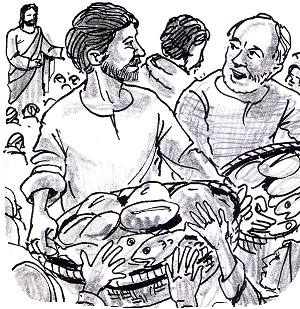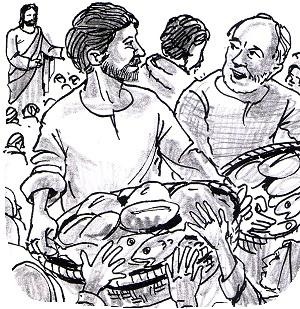

“Do this in remembrance of me” (1 Cor 11:25).
The Body and Blood of Jesus Christ
Gn 14:18-20; Ps 110; 1 Cor 11:23-26: Lk 9:11b-17
The miracle of the multiplication of loaves and fishes, repeated in all four Gospels, is clearly a gateway to the kerygma, or basic faith proclamation by the church, about who Jesus was and is.
As a key historical memory, it confirms that Jesus was perceived in his time as a messianic figure by both his popular following and by the authorities. Ched Meyer’s cogent political reading of Mark’s Gospel, Binding the Strong Man, posits that anyone who could assemble and feed 5,000 men in the wilderness while the Temple establishment was celebrating Passover in Jerusalem was a threat to the high priest and to Caesar.
The early church adopted the scriptural image of Moses and manna in the wilderness as fulfilled in Jesus but backed away from any political reading as it sought its place in the empire and among its expanding Gentile converts.
What was left of the multiplication event and its interpretation for the church as it moved toward a doctrinal understanding of Jesus was the rich theology of Jesus as the Bread of Life and the Cup of Salvation we celebrate at every Mass.
St Paul mined the Passover imagery and Eucharistic practice of the primitive church to articulate Jesus as the incarnate presence of God in history and the church as the body of Christ extended in time. When the faith communities he founded opened the Scriptures, broke the bread and shared the cup around the Lord’s Table, they became what they ate and drank, the body and blood of Jesus the Christ.
If baptism is our incorporation into this body, Communion is how we grow to maturity in our Christian identity. The Spirit of Jesus animates us as the body of God, the Trinity of Love indwelling us and empowering us to renew creation toward its original purpose as the image of God.
The Second Vatican Council rescued the Eucharist from sacred object of devotion to the dynamic “real presence” of the risen Christ in the Word, the consecrated bread and wine, the presider and the praying assembly. Today, on this Solemnity of the Body and Blood of Christ, we celebrate all four forms of presence, and we accept the implications of each one in our lives.
First, we cannot know Jesus if we do not pray and study the Scriptures. Second, receiving the Eucharist regularly is our privilege and absolutely necessary for our baptismal maturity. Third, those who preside in the image of Jesus must serve as he did. Finally, the entire assembly prays the Mass, offers itself in union with the crucified Christ and receives itself back in his risen life in Communion, which it then takes into the world as the church. Each of us is an evangelist and an agent of redemptive mercy. All of us together are the Beloved Community that reveals the future of humanity.
If this seems abstract, perhaps it is because it only becomes real if we live it. But if we trust the Holy Spirit, who never ceases to teach us in every breath we take that we are Jesus in the world, we will experience him in every thought and every act he inspires in us, and in the pulse of his blood in our veins, and in the glory that is even now coursing through our bodies as we surrender ourselves to his service.
What other identity, purpose and promise can so fully match our desire to be one in love with God and with each other? What other dream is there that can thrill our hearts with such joy?
Advertisement






